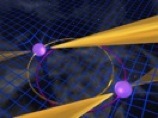Michael Kramer
Research
Radio astronomical measurements allow the study of a variety of questions in fundamental physics. Those questions range from the equation-of-state of super-dense matter to the investigation of fundamental forces such as gravity and magnetism. In particular, I am interested in searching for and exploiting fast-rotating neutrons stars that are visible as radio pulsars. Their observations allow us to test general relativity and alternative theories of gravity and works towards the detection of a long-wave cosmological gravitational wave background. The variety of applications enabled in particular by pulsars is reflected in my research interests which are broadly listed below. Each section gives examples of some corresponding publications. I am also involved in planning future facilities such as the SKA and LOFAR and the exciting science that they will enable.
Gravitational Physics & Cosmology
Pulsars are very compact objects, exhibiting the strongest gravitational fields
next to black holes. Acting as cosmic lighthouses and precise cosmic clocks,
pulsars can be used to probe gravitational physics under strong-field conditions and to detect low-frequency gravitational waves.
Determination of the Geometry of the PSR B1913+16 System by Geodetic Precession
Strong-field tests of gravity using pulsars and black holes

Pulsars & Neutron star properties
Pulsars are known for 40 years, but our understanding of their emission across the
electromagnetic spectrum - in particular at radio frequencies - is still very limited.
Nevertheless, we can use pulsars to study the most extreme matter in the Universe!
Transient radio bursts from rotating neutron stars
Polarized radio emission from a magnetar
A Periodically Active Pulsar Giving Insight into Magnetospheric Physics

Galactic & Environmental Probes
Pulsar emission is affected by the ionized magnetic medium when the signals are
propagating to Earth. Studying the interaction allows us to use pulsars to probe the
Milky Way and the environment which they are found in. The mysterious Fast Radio Bursts (FRBs) that we study even allow to probe the intergalactic space!
Anomalous Scattering of Highly Dispersed Pulsars
Detection of Ionized Gas in the Globular Cluster 47 Tucanae

Binary & Stellar Evolution
Pulsars are the remnant of massive stars, born in supernova explosions. Frequently,
they have a companion which can spin-up the pulsar to millisecond periods after its
normal “death”, producing recycled pulsars and perhaps double neutron star systems.
The Proper Motion, Age, and Initial Spin Period of PSR J0538+2817 in S147
PSR J1756-2251: A New Relativistic Double Neutron Star System
A Double-Pulsar System: A Rare Laboratory for Relativistic Gravity and Plasma Physics
